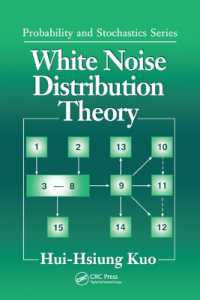Full Description
This is the 137th volume of the Jossey-Bass quarterly report series New Directions for Community College. Essential to the professional libraries of presidents, vice presidents, deans, and other leaders in today's open-door institutions, New Directions for Community Colleges provides expert guidance in meeting the challenges of their distinctive and expanding educational mission.
Contents
Editors' Notes (Pamela L. Eddy, John P. Murray). 1. Classifying Community Colleges: How Rural Community Colleges Fit (David E. Hardy, Stephen G. Katsinas) This chapter describes rural community colleges, compares them to their urban and suburban counterparts, and highlights the unique challenges they face in the twenty-first century. 2. The Rural Differential: Bridging the Resource Gap (Charles Fluharty, Bill Scaggs) Much of rural America remains in continuing economic decline. Rural locales create a "rural differential" in grant making. Partnering with other colleges and community organizations can help ameliorate this resource gap. 3. Connecting Rural Community Colleges to Their Communities (Michael T. Miller, Daniel B. Kissinger) Rural community colleges contribute to their communities' sense of identity and engagement through continuing education and other noncredit activities. 4. "Ruralizing" Presidential Job Advertisements (Jay Leist) Advertisements for community college presidents often fail to stress the special issues, leadership challenges and opportunities, and community expectations confronting a rural two-year institution and its senior leader. This chapter proposes changes for future job advertisements. 5. Engaging Leaders as Builders of Sustainable Rural Communities: A Case Study (Molly M. Clark, Ed Davis) This case study describes a leadership model that links college executives, practicing community and economic developers, and universitybased scholars in leader formation processes, with the goal of building sustainable rural communities. 6. Recruiting and Retaining Rural Community College Faculty (John P. Murray) Rural community colleges cannot offer the financial, cultural, and social advantages that more urban institutions can. This chapter describes the factors rural community college leaders must consider when recruiting and retaining new professors. 7. Faculty Development in Rural Community Colleges (Pamela L. Eddy) This chapter describes results from a national study of community college faculty development programs. Findings highlight how the challenges rural colleges face differ from those faced by urban institutions, which are more likely to have dedicated faculty development centers. 8. Residential Living at Rural Community Colleges (Pat G. Moeck, David E. Hardy, Stephen G. Katsinas) This chapter dispels the myth that community colleges do not have residence halls and discusses implications of residential living for both students and rural community college administrators. 9. Connecting to the Larger World: Distance Education in Rural Community Colleges (Brent D. Cejda) Distance education has been promoted as a potential "equalizer" for rural community colleges. This chapter reviews the limited research on the use of distance education by rural community colleges and addresses some of the technological issues these colleges face. 10. Strategizing for the Future (Pamela L. Eddy, John P. Murray) This chapter reviews the strategies described in this volume that rural community college leaders can use to address the issues and challenges they face. INDEX.







